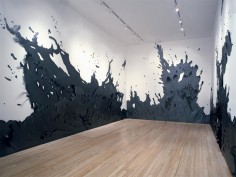andreas kocks
Андреас Кокс
source: meuspensamentospensamblogspotcombr
Andreas Kocks é alemão , vive e trabalha entre Nova York e Munich. As suas instalações feitas com papel recortado e pintado a acrílico branco ou a grafite ,alteram a relação geométrica do espaço de modo emotivo. A impressão que fica é de paredes que se transformam em organismos quase naturezas vivas , que expandem para além dos limites, com uma vitalidade inusual à matéria inerte.
.
.
.
.
.
.
.
source: patternprintsjournalit
Queste splendide installazioni e sculture, tutte di carta, sono opere di Andreas Kocks, artista tedesco che vive e lavora tra New York e Monaco.
Grandioso l’effetto scenografico di queste opere di carta!
.
.
.
.
.
.
.
source: ecbloguer
Andreas Kocks es un artista nacido en 1960 en la ciudad de Oberhausen, Alemania. Estudió en la Academia de Düsseldorf, con Norbert Kricke, Ulrich Rückriem and Erich Reusch. Su trabajo denota el conocimiento de la materia, por parte del artista, y subvertir escalas a partir de materiales leves para generar espacios dentro del espacio.
.
.
.
.
.
.
.
source: aurinko-borealisblogspot
Андреас Кокс (Andreas Kocks) — германский скульптор, родившийся в городе Оберхаузен. Свои экспрессивные творения Andreas Koсks предпочитает называть скульптурами из бумаги. На первый взгляд его работы вызывают ощущение, как будто на стену вылили ведро чёрной краски или чернила, но на самом деле это бумажная инсталляция.
В своих работах Andreas Kocks использует лишь бумагу, отказавшись от традиционных материалов, таких как бронза, сталь, цемент.
Считая бумагу универсальным материалом для реализации своих идей, автор вырезает из бумаги детали, создавая из них ошеломляющие пространственные инсталляции.
Andreas Kocks размещает свои работы самостоятельно.
.
.
.
.
.
.
.
source: trendhunter
Andreas Kocks makes some awesome three dimensional paper splatter sculptures. You might tend to think that splatter art may not take a whole lot of thought or effort, but that does not describe the paper creations of Andreas Kocks.
Just looking through this gallery of paper splatter sculptures from Andreas Kocks’ paperworks collection spurs emotion, and although you may not have seen his work before, you may find yourself lost in his messy musings.
Implications – This unusual form of representation by Andreas Koks is highly refreshing and unexpected in the eyes of viewers. His ability to forsake all his inhibitions in order to create paper splatter sculptures with in-depth emotion is highly addicting to viewers. Those with an appreciation of messy artwork are going to adore these cool sculptures.
.
.
.
.
.
.
.
source: beautifuldecay
Andreas Kocks‘s playful paper installations are loud, and usually appear at first glance to be a mess left behind by a band of rowdy children. Upon further inspection, one can note the thought and detail that went into every one of his works: the layers of cut paper that together comprise a three dimensional “splatter”, or the rows of tiny slits and holes that transform heavy sheets of paper into foamy lace seeming to flow out through cracks in the walls.
.
.
.
.
.
.
.
source: blogreflexdecofr
« What kind of act is it to cut through a surface? Potentially savage, vicious and even violent, it could also be a kind of surgery or suture – a sign of healing and reparation to come. A cut is the way we speak of discharging someone – we cut them out or cut them deeply – a social metaphor based on a knife’s sharp line – the knife’s social sharpness that ruthlessly stabs in the back. But a cut is also a break, a release, a change, a sudden movement that is transformative – metamorphasizing from one state to another, the cut that stitches time and images in movies – the cut that binds by being the cut that releases and frees. The difference that is the remove of courage. But always the edge is central, the edge of one thing and the space that inhabits the difference between two planes, two levels. It scores, it engraves, it incises, it precises..
In contemporary art, the cut is associated primarily with the aesthetic legacy of Lucio Fontana, Italian artist and texturist par excellence (not textualist mind you). Fontana’s constant and inventive work stabs, punctures, slices and dices in its vivid attack on the modernist picture plane (and 1949 has been called the “year of the cut”, a moment of highlighting the torn, the ripped and the deliberately pierced in painting and collage). After Hiroshima, no surface capable of containing the poetry to conflate Adorno and the disillusioned European artists of that moment. But, like other avant-garde methodologies and politically aware art, its lessons are, today, played out with more nuance and less severity in their positioning.
Andreas Kocks understands these lessons from recent history and enhances both their extreme physicality and their metaphoric potential. He too cuts and marks deeply into a surface but his chosen medium is somewhat pliant, not as resistant as Fontana’s deliberately obdurate faces. Having abandoned the weight (the gravitas) of sculpture (steel, bronze, lead, cement), Kocks took to paper, the substance which sits between staid material and full elasticity – the stuff that artists return to again and again as though it is an ur substance of alchemy whether they be post-modernists or reactionaries. Together with the full exploration of the dimensional space in which his works reside, he carefully constructs a dialogue which is outside of outside of sculpture, outside of drawing and outside of time (or at least the historical time of style). This set of methods of abandoning something (a medium for instance) is the cut he performs before cutting into and through the passive, almost neutral manuscript and the benign spaces it occupies.. Incising, engraving in space, layering through the peel of the skin, Kocks manufactures an explosive image. The contradiction is observable. A careful methodology – a caring methodology even – the slowly emerging skeins are somehow now full of energy – they give off a palpable sense of movement and direction. They are optical maelstroms on the wall, on the ceiling, on the floor. Sweeping broadly away from the viewer and around at the same time, the work strangely accomplishes much more than its simple techniques would seem to promise.
I think for me what is the most improbable, and thus enjoyable and provocative, is that the actual works – made of simple cut lines and graceful negative spaces in white or black – are so emotional. They burst with a barely constrained and refined unconscious jolt. For me, Andreas Koks has somehow, in this weird and unexpected act of representation, unleashed from a history which began as resistant or even antagonistic, found a place where power can be unearthed without threat, where violence can be contemplative, where ferocious acts can be redemptive and where an image might tender the hope its process of creation offers. »
.
.
.
.
.
.
.
source: designisthis
Ο Γερμανός γλύπτης Andreas Kocks χρησιμοποιώντας ως πρώτη ύλη το χαρτί δημιουργεί καταπληκτικά τρισδιάστατα έργα τέχνης.
Χρησιμοποιώντας το χαρτί για την δημιουργία μεγάλων τρισδιάστατων γλυπτών ο καλλιτέχνης επιθυμεί να υπογραμμίσει την τρισδιάστατη υπόσταση του χαρτιού, ενός υλικού που συνήθως παρουσιάζεται ως δυσδιάστατο και επίπεδο. Τα έργα του Kocks έχουν μια ιδιαίτερα δυναμική αίσθηση και τονίζουν τις δυνατότητες του χαρτιού ως υλικό γλυπτικής.
Όλα τα δημιουργήματα του, έχουν επίσης έντονο το στοιχείο της ρευστότητας και παραλληλίζουν το χαρτί με την μπογιά, προσπαθώντας να απεικονίσουν κίνηση και ελαστικότητα που φαντάζει ασύμβατη με την φύση του υλικού. Έτσι η οργανική ρευστή μορφή των δημιουργημάτων του Kocks, έρχεται σε πλήρη αντίστιξη με το ορθογώνιο γεωμετρικό σχήμα των τοίχων στους οποίους τοποθετούνται, τονίζοντας τη σχέση μεταξύ γλυπτικής και αρχιτεκτονικής.
Επιλέγοντας να χρησιμοποιεί μόνο λευκό και μαύρο χρώμα ο καλλιτέχνης υποβαθμίζει τη δύναμη του χρώματος και βασίζεται στην ακρίβεια των σχημάτων και στην προσεγμένη συμμετρία για να παράξει ένα δυνατό και ξεχωριστό οπτικό αποτέλεσμα.
Τα γλυπτά “Paperworks” σηματοδοτούν μια δραστική στροφή στην πορεία του καλλιτέχνη, καθώς έχουν τεράστιες διαφορές από τις προηγούμενες δουλειές του. Επί μια περίοδο περισσότερων από 10 ετών, ο Kocks χρησιμοποιούσε υλικά όπως ξύλο, τσιμέντο και φύλλα χρυσού. Η μετακόμιση του από το Μόναχο στην Νέα Υόρκη όμως έφερε και μια δημιουργική στροφή, η οποία όπως όλα δείχνουν έχει εκτοξεύσει την διεθνή αναγνώριση του Γερμανού καλλιτέχνη στα ύψη. Ο Kocks διαμένει και εργάζεται επό του παρόντος στην Νέα Υόρκη, αλλά και στο Μόναχο.
Ο Andreas Kocks γεννήθηκε το 1960 στο Oberhausen της δυτικής Γερμανίας. Σπούδασε γλυπτική στο Kunstakademie Düsseldorf και οι δουλειές του χαίρουν ευρείας αναγνώρισης τόσο στην Ευρώπη όσο και στην Αμερική. Έργα του καλλιτέχνη βρίσκονται στις μόνιμες συλλογές μουσείων όπως το “Museum für Konkrete Kunst, Ingolstadt”, το “Bayerische Staatsgemäldesammlungen, Munich” και το “Maxine and Stuart Frankel Foundation for Art, Michigan”. Επίσης το 2006 κέρδισε το σημαντικό “Pollock-Krasner Foundation Grant” μια χρηματοδότηση για διακεκριμένους επαγγελματίες καλλιτέχνες που δίνεται από το ίδρυμα “Pollock-Krasner Foundation”.


